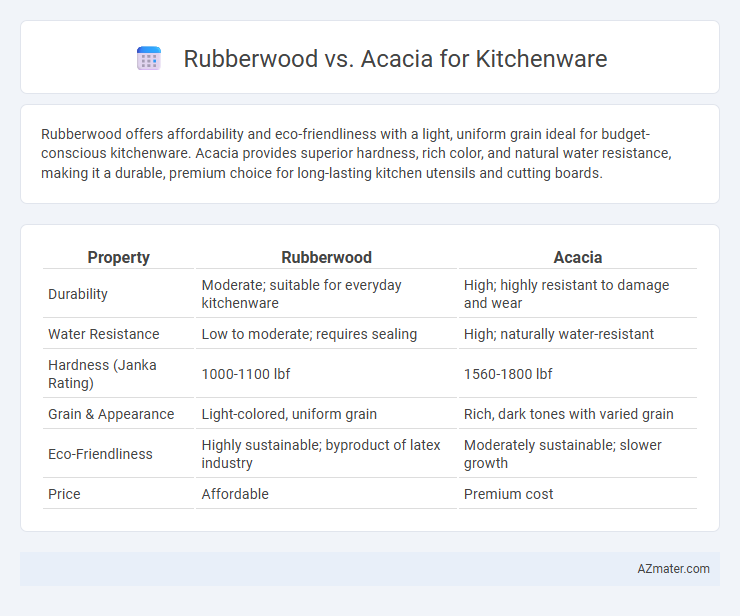Rubberwood offers affordability and eco-friendliness with a light, uniform grain ideal for budget-conscious kitchenware. Acacia provides superior hardness, rich color, and natural water resistance, making it a durable, premium choice for long-lasting kitchen utensils and cutting boards.
Table of Comparison
| Property | Rubberwood | Acacia |
|---|---|---|
| Durability | Moderate; suitable for everyday kitchenware | High; highly resistant to damage and wear |
| Water Resistance | Low to moderate; requires sealing | High; naturally water-resistant |
| Hardness (Janka Rating) | 1000-1100 lbf | 1560-1800 lbf |
| Grain & Appearance | Light-colored, uniform grain | Rich, dark tones with varied grain |
| Eco-Friendliness | Highly sustainable; byproduct of latex industry | Moderately sustainable; slower growth |
| Price | Affordable | Premium cost |
Introduction: Rubberwood vs Acacia in Kitchenware
Rubberwood and Acacia are popular woods for kitchenware due to their durability and aesthetic appeal. Rubberwood, sourced from the Para rubber tree, offers a light color and smooth grain ideal for cutting boards and utensils, while Acacia is prized for its rich, dark tones and natural water resistance. Both woods provide sustainable options, but Acacia's hardness and dense grain typically deliver greater longevity for heavy kitchen use.
Overview of Rubberwood Properties
Rubberwood is a sustainable hardwood derived from the Para rubber tree, known for its medium density and smooth grain, making it ideal for kitchenware such as cutting boards and utensils. It exhibits high resistance to moisture and moderate durability while being less porous than many other hardwoods, reducing the risk of bacterial growth in kitchen environments. Its light color and ability to take stains well allow for versatile finishes that complement a variety of kitchen aesthetics.
Acacia Wood: Key Characteristics
Acacia wood is highly valued for kitchenware due to its durability, natural resistance to water and microbes, and rich, warm tones that enhance aesthetic appeal. Its dense grain structure creates a smooth finish that resists cracking and warping, making it ideal for cutting boards, utensils, and bowls. Sustainable harvesting practices and the wood's renewable qualities also contribute to its popularity among environmentally conscious consumers.
Sustainability and Environmental Impact
Rubberwood is highly sustainable, sourced from rubber trees after latex extraction, reducing waste and promoting reforestation, while Acacia, though durable and visually appealing, is often harvested from slower-growing trees, impacting long-term forest regeneration. Rubberwood's use in kitchenware supports eco-friendly practices due to its fast renewal and lower carbon footprint compared to Acacia. Choosing rubberwood kitchenware significantly minimizes environmental impact through sustainable forestry and efficient resource use.
Durability and Strength Comparison
Rubberwood offers moderate durability and strength suitable for lightweight kitchenware, benefiting from its resistance to warping and cracking. Acacia boasts superior hardness and density, making it highly durable and ideal for heavy-use kitchen items due to its natural resistance to scratches and moisture damage. Choosing Acacia ensures long-lasting performance in demanding kitchen environments, while Rubberwood suits more decorative or less frequently used utensils.
Appearance and Aesthetic Differences
Rubberwood features a light, creamy color with a subtle, uniform grain that offers a clean and minimalist aesthetic ideal for modern kitchenware. In contrast, Acacia wood displays rich, warm tones ranging from golden brown to deep amber, with dramatic, swirling grain patterns that create a distinctive and rustic appearance. The smooth finish of Rubberwood presents a soft matte look, while Acacia's natural oils provide a glossy sheen, enhancing the wood's visual depth and character in kitchen utensils and cutting boards.
Maintenance and Care Requirements
Rubberwood kitchenware demands moderate maintenance with regular oiling to prevent drying and cracking, while its resistance to warping makes it durable in humid environments. Acacia requires more frequent conditioning due to its natural oil content, which helps maintain its rich color and prevents surface drying. Both woods benefit from hand washing and immediate drying to extend their lifespan and maintain their aesthetic appeal.
Price and Value for Money
Rubberwood offers an affordable option for kitchenware, providing decent durability and sustainability at a lower price point compared to Acacia. Acacia kitchenware, while more expensive, delivers superior hardness, scratch resistance, and a rich, natural aesthetic that enhances long-term value. Choosing Rubberwood suits budget-conscious buyers prioritizing eco-friendliness, whereas Acacia appeals to those seeking premium quality and lasting performance.
Safety and Food Compatibility
Rubberwood is prized for its non-toxic nature and resistance to moisture, making it a safe choice for kitchenware that comes into direct contact with food. Acacia wood offers natural antibacterial properties and durability, which enhances food safety and longevity of utensils. Both woods are food-safe, but Rubberwood's stability and Eco-friendly harvesting make it particularly suitable for sustainable kitchenware.
Which is Better for Kitchenware: Final Verdict
Rubberwood offers durability, resistance to cracking, and an eco-friendly profile due to its sustainable harvesting from rubber trees after latex production. Acacia, prized for its dense grain and natural resistance to moisture and bacteria, provides superior longevity in kitchenware applications. For kitchenware, Acacia is generally better due to its enhanced hardness and antimicrobial properties, ensuring longer-lasting, hygienic utensils and cutting boards.

Infographic: Rubberwood vs Acacia for Kitchenware
 azmater.com
azmater.com